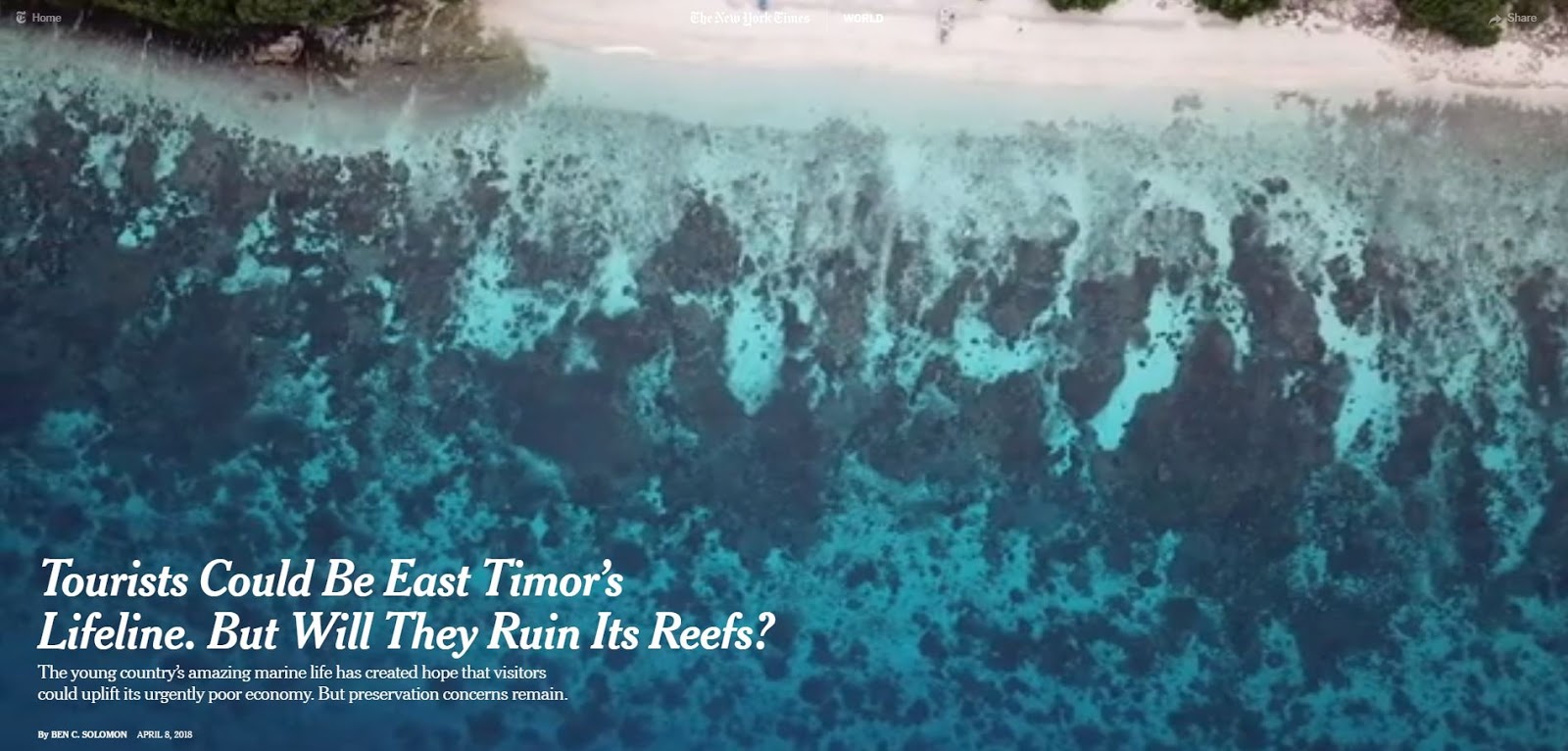https://www.nytimes.com/2018/04/08/world/asia/east-timor-reefs-tourism.html?emc=edit_th_180409&nl=todaysheadlines&nlid=666716390409WORLD
COM, East Timor — On a rainy spring morning, Fizzy Moslim strapped on her weathered-chrome oxygen tank and slipped into the warm water.
Few visitors make it out to the sleepy fishing village of Com, a backbreaking seven-hour drive from the capital, and usually no one except the locals ever dives into its waters.
Below she found an underwater metropolis. Sea turtles swam beside hundreds of reef fish, feeding on the rich coral below. Two young dugong, a manatee-like sea mammal, sped away, and a blacktip reef shark swam along the ocean floor.
“This isn’t even nearly the best of what I’ve seen,” said Ms. Moslim, an instructor for Compass Diving tours, as she came up from the depths.

In March, Ms. Moslim and a team of divers and conservationists set out on a mission to chart these sea sanctuaries in hopes of bringing in a new kind of species here: tourists.
“If these corals will stay strong, the people around them will need the money to keep them safe,” said Trudiann Dale, the East Timor country director for Conservation International. “Eco-tourism, if done right, could provide that.”
The tiny country of East Timor is surrounded by some of the most magnificent and untouched marine life in the world. Off the island of Atauro alone, researchers have discovered 253 reef fish species, surpassing the world record.
But 16 years after gaining its independence after decades of bloody occupation, East Timor remains the poorest country in Southeast Asia. As politicians struggle to find new economic streams like oil pumping and coffee exports, none have proved powerful enough to raise the country out of poverty.
The question for conservationists and government officials is clear: How can the country both develop tourism and keep its pristine beauty?

ATAURO I.
Com
Dili
Savu Sea
EAST TIMOR
Timor Sea
INDONESIA
50 MILES
South China
Sea
PHILIPPINES
Pacific Ocean
MALAYSIA
INDONESIA
Jakarta
Java Sea
Area of
detail
Indian Ocean
BALI
AUSTRALIA
1,000 MILES
25
50
100
Miles
“It’s a hard thing,” said Manuel Mendes, head of the Department of Protected Areas and National Parks for East Timor, noting his country’s susceptibility to climate change and drought. “We know that if we just leave it all alone, it will soon be gone.”
Around the world, coral is being wiped out. According to the conservation group W.W.F., almost a quarter of coral reefs worldwide are damaged beyond repair. The rest are under threat from rising sea temperatures, harmful fishing practices and vicious tourism.
“We don’t want to end up like Bali,” said Ms. Dale, referring to the nearby tourist center’s “garbage emergency” last year, when nearly 100 tons of garbage washed up on the island’s beaches.



Since declaring independence in 2002, after suffering years of harsh occupation by the Indonesian military, East Timor has been struggling to find its feet.
“During the Indonesian time, soldiers would throw grenades in the reef to fish,” said Zanuari Marteans, a 60-year-old fisherman from Atauro Island. “We hid in the villages and watched them destroy. We could do nothing.”
In the years after independence, the country had one of the highest fertility rates in the region, with almost seven births per mother. Sixteen years later, most of the population is younger than 25, with unemployment on the rise.
Since 2004, almost 80 percent of East Timor’s gross domestic product has come from the oil field in the Timor Sea, where reserves are projected to run dry by 2023. In March, the ex-rebel leader and independence hero Xanana Gusmão led negotiations with Australia, expanding East Timor’s sea border and giving hopes for an extended deal worth billions more. But discussions on where the oil will be pumped continue, and East Timor is struggling to find jobs for the growing population.
The reef development here is no accident. For generations, local fishermen have safeguarded their supplies of fish by creating marine protected areas. Communities would agree on the boundaries, mark them off and ban fishing there: no nets being dragged around, no rumbling boat motors. In these areas, fish and coral develop untouched, so future generations have a chance to fish them.
In 2016, the East Timorese government started putting these practices into law. It created a budget and started paying rangers to help out. But the budget is minuscule and barely covers the enforcers’ salaries.
Accordingly, much of the day-to-day work around the reefs has remained with the fishing communities.
Inside a concrete shack to protect from the hot midday sun, Ms. Dale gathered a group of local fishermen and hotel owners together with Compass Diving, based in Dili, to share ideas for eco-tourism.
Their pristine reef, she explained, could bring in divers from around the world who would pay good money to explore them. The fishermen sat smoking cigarettes with their arms guardedly crossed.
“We don’t know where to start,” said Lucas Monteioro, 32, a jobless resident of Com. “The community is interested in tourism and making new money, but people here only have the sea.”



The truth is that tourism has remained starkly low, with the Asia Foundation estimating that only about 5,000 tourists a year make it to East Timor. Roads are rocky and inaccessible, and flights to get in the country are sparse and expensive.
Given that, eco-tourism is still not a realistic priority for governmental leaders, though there is hope it will improve.
In parts of the country, big-money hotels have already started contracting developments. Government proposals have included turning East Timor into a Macau-like tax haven and casino destination.
But for the fishermen here, the weight of the preservation will remain a central part of their lives.
“These fish are our life, and the reef is their house,” said Mr. Marteans, sitting up from an afternoon nap in the warm sand and getting ready for an evening fishing run. “If someone has no house, how can they live?”




